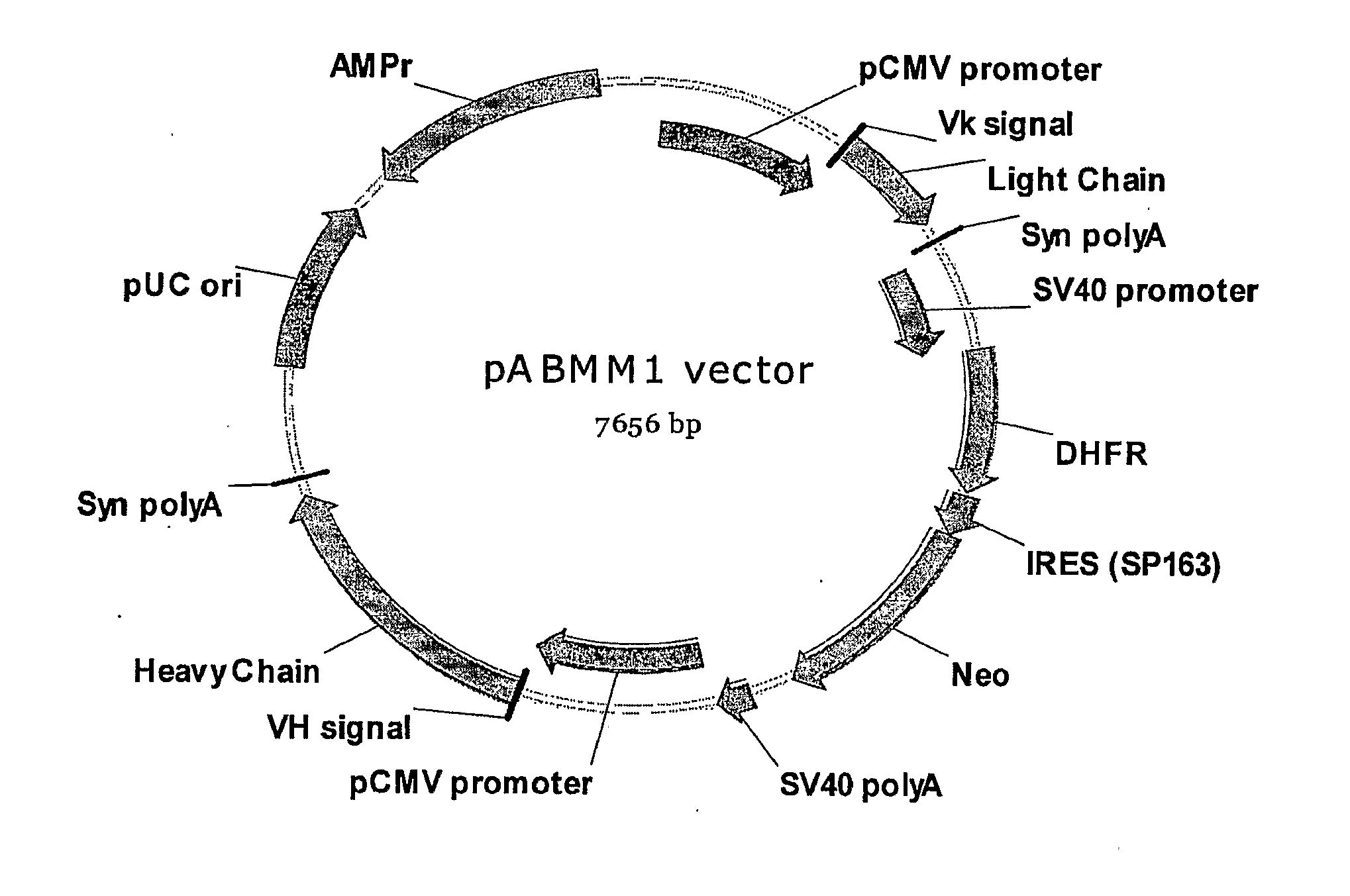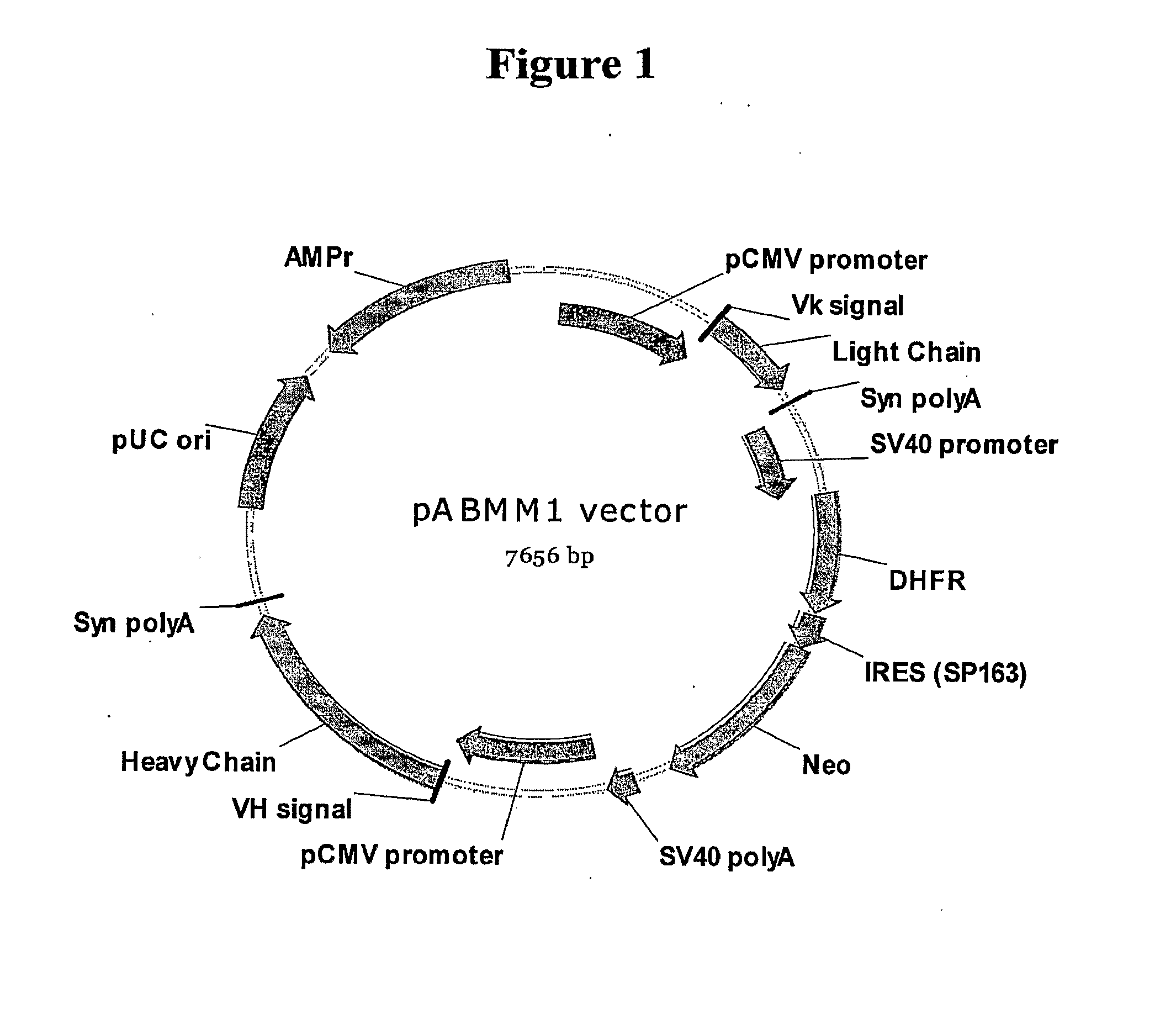Method for Producing Stable Mammalian Cell Lines Producing High Levels of Recombinant Proteins
a cell line and stable technology, applied in the direction of viruses/bacteriophages, genetically modified cells, antibacterial agents, etc., can solve the problems of high copy number cell line instability, cytogenetic heterogeneity, and inability to produce robust biopharmaceutical proteins in mammalian cells, so as to achieve high levels of biopharmaceutical proteins and modulate the efficiency of mammalian cell transfection
- Summary
- Abstract
- Description
- Claims
- Application Information
AI Technical Summary
Benefits of technology
Problems solved by technology
Method used
Image
Examples
example 1
pABMM1 Vector Construction for IgG Expression in Mammalian Cells
[0064]pABMM1 (SEQ ID NO; 1) was created from a backbone vector pcDNA6 / His-5A by following three steps. First, the DNA fragment coding an expression cassette for two selection makers DHFR / neomycin was assembled through overlapping PCR from 5 DNA fragments, which are synthetic polyA, SV40 promoter amplified by PCR from vector pcDNA3, DHFR cDNA amplified by RT-PCR from the RNA of CHO-K cell, synthetic SP163 (Internal Ribosome Entry site from 5′ UTR of VEGF), and Neomycin cDNA amplified by PCR from vector pcDNA3. The DNA fragment of PolyA-SV40 promoter-DHFR-SP163-Neomycin was cloned into vector pcDNA6 / His-5A by NheI and Drain restriction sites.
[0065]Second, a DNA fragment coding for human antibody signal peptide, partial Jk segment and human k constant region was inserted downstream of pCMV promoter in the modified pcDNA 6 vector described above. This DNA fragment was generated from, PCR assembly, in which the signal sequen...
example 2
pABMM72 Vector Construction for IgG Expression in Mammalian Cells
[0067]paBMM72 (SEQ ID NO: 2) was derived from pABMM1. The SV40 promoter for DHFR / Neomycin in pABMM1 vector was replaced by an internal ribosome entry sequence SP163 in BamHI / NcoI sites, resulted in one transcription for the antibody light chain, DHFR, and neomycin driven from single CMV promoter in pABMM72 vector. Furthermore, an anti-VEGF antibody heavy and light chain variable region genes VH and Vk were cloned into this vector respectively by NheI / BsiWI and AflII / XhoI sites.
example 3
pABMM48 Vector Construction for IgG Expression in Mammalian Cells
[0068]pABMM48 (SEQ ID NO: 3) was constructed from pABMM1 vector as described below. First, the antibody (anti-VEGF antibody) heavy and light chain variable region genes VH and Vk were cloned into this vector respectively by NheI / BsiWI and AflII / XhoI sites. Second, a 1540 bp of DNA fragment for retrovirus Gag-Pr gene fragment was inserted into BglII site upstream of CMV promoter of light chain. The retrovirus Gag-Pr DNA fragment (SEQ ID NO: 4) was amplified from CHO-DG44 cells by PCR. It has two open reading frames coding truncated gag-pr proteins (amino acid 30-381, and 383-545, with a stop codon between), and 61% ( 317 / 518) identity with murine leukemia virus gag-pol polyprotein (full length of 1736 amino acids). Third, a 1462 bp of DNA fragment (SEQ ID NO: 5) for retrovirus Env gene was amplified from CHO-DG44 cells by PCR, and was inserted into SalI site downstream of heavy chain expression cassette. The Env fragmen...
PUM
| Property | Measurement | Unit |
|---|---|---|
| voltage | aaaaa | aaaaa |
| temperature | aaaaa | aaaaa |
| temperature | aaaaa | aaaaa |
Abstract
Description
Claims
Application Information
 Login to View More
Login to View More - R&D
- Intellectual Property
- Life Sciences
- Materials
- Tech Scout
- Unparalleled Data Quality
- Higher Quality Content
- 60% Fewer Hallucinations
Browse by: Latest US Patents, China's latest patents, Technical Efficacy Thesaurus, Application Domain, Technology Topic, Popular Technical Reports.
© 2025 PatSnap. All rights reserved.Legal|Privacy policy|Modern Slavery Act Transparency Statement|Sitemap|About US| Contact US: help@patsnap.com



